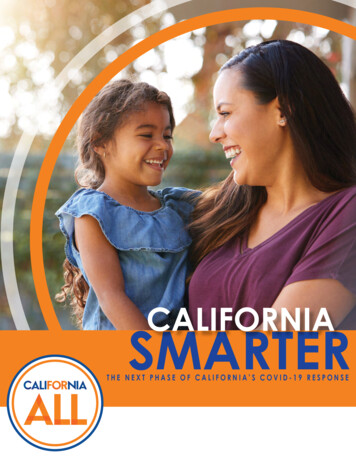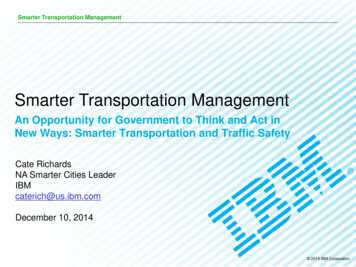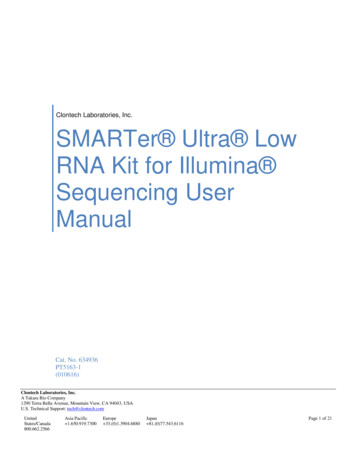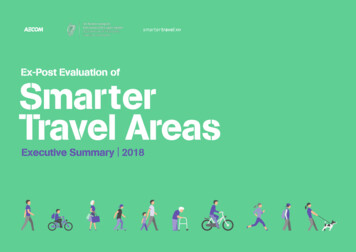
Transcription
CALIFORNIASMARTERTHE NEXT PHASE OF CALIFORNIA’S COVID-19 RESPONSE
Table of ContentsIntroduction. 3The SMARTER Plan Includes. 4The SMARTER Plan in Action. 5SMARTER by the Numbers. 6Putting Our Work Into Context. 7Remaining Nimble and Adaptable. 8Maintaining and Expanding Focus on Equity. 8The SMARTER Plan. 10SHOTS. 11MASKS. 13AWARENESS. 14READINESS. 16TESTING. 18EDUCATION. 20RX. 22Building on Experience. 23Investments to Fight COVID-19. 28Conclusion. 292California SMARTER February 2022
IntroductionCalifornians have led the nation’s fight against the COVID-19 pandemic with early publichealth measures that saved lives. We have been led by science and data, and know moretoday than we did two years ago.The release of the California SMARTER Plan: The Next Phase of California’s COVID-19Response is critically timed. We are recovering from the intense Omicron variant surge whenmillions of Californians were infected. It is clear the virus will remain with us for some time, ifnot forever. It is less clear how often and how much it will continue to impact our health andwell-being. However, we know what works, and have built the necessary tools over the lasttwo years that allows us to learn and hone our defenses to this virus as it evolves.As we enter the next phase with COVID-19, which may include future surges and newvariants, we will continue to be the nation’s model for preparedness, ready to build on whatwe have learned over the past two years to meet the COVID-19 challenges that lie ahead.In our approach to this next phase, we will be smarter than ever before, using the lessons ofthe last two years to approach mitigation and adaptation measures through effective andtimely strategies. Throughout the pandemic we have leaned on science and relied on toolsthat create protection. This includes vaccines, masks, tests, quarantine, improving ventilation,and new therapeutics. Moving forward, based on the evolving conditions of the virus, wewill be prepared to use these different strategies in more precise and targeted ways all alongthe way, integrating new innovations and information to protect our state.Federal, state and local leaders must continue to prepare for the future, even thoughwe cannot fully predict it. But California’s path forward will also be predicated on ourindividual, smarter actions, that will collectively yield better outcomes for our neighborhoods,communities, and state. The main points of the SMARTER plan are as follows:SMARTERShots- Vaccines are the most powerful weapon againsthospitalization and serious illness.Masks- Properly worn masks with good filtration help slowthe spread of COVID-19 or other respiratory viruses.Awareness- We will continue to stay aware of how COVID-19 is spreading,evolving variants, communicate clearly how people should protectthemselves, and coordinate our state and local government response.Readiness- COVID-19 isn’t going away and we need to be ready withthe tools, resources and supplies we will need to quickly respond andkeep public health and the health care system well prepared.Testing- Getting the right type of tests - PCR or antigen - to wherethey are needed most. Testing will help California minimize thespread of COVID-19.Education- California will continue to work to keep schools openand children safely in classrooms for in-person instruction.Rx- Evolving and improving treatments will become increasingly availableand critical as a tool to save lives.California SMARTER February 20223
The SMARTER Plan Includes With the COVID-19 Assessment and Action Unit the state will monitorthe data and frontline conditions in real-time to ensure Californiais ready to respond to new and emerging variants and changingconditions. Building upon a robust, regionally based waste-water surveillance andgenome sequencing network to have early and rapid insights into thechanging nature of the virus and early identification of variants. Thisnetwork can be scaled up to support identification of future infectiousdiseases. Work with external partners and the federal government to launchthe first-in-the-nation impacts of COVID-19 longitudinal cohort studyto look at and follow the direct and indirect impacts of COVID-19 onindividuals and communities over time. Pursue of a public-private partnership with a test manufacturer to drivedown the costs of at-home tests while securing a reliable and timelysupply chain for California. Take steps to ensure our health care facilities can continue to rampup with additional staff and resources to respond to surges to minimizethe strain on our health care systems.The SMARTER Plan reflects upon what we have done as a state and how we have learnedto manage COVID-19. Our lessons and experiences inform our approach to manage whatlies ahead. We will stay prepared for whatever COVID-19 might bring our way next and wewill continue to lean on the tools that worked to reduce spread, minimize infection and keepour community safe.SMARTER is not just for or during COVID-19. The preparation, the flexibility and the systems wehave developed make us SMARTER and better prepared for future emergencies. Our statewill continue to learn and iterate in our response to the virus. California has always been astate that learns fast and adapts – it is in our DNA and will guide us moving forward.4California SMARTER February 2022
The SMARTER Plan in ActionAs California maintains focus on communities disproportionately impacted, the SMARTERPlan outlines specific steps to prepare and be ready for the next covid-19 threat.To put this into practice, imagine a California county through its wastewater surveillancesystem picks up a signal indicating a higher level of transmission of COVID-19 than normal.Californians should expect the following six efforts to kick into action:1. Sequence the circulating strain, and answer the question: “Is thecirculating strain a variant we know or is it new?” If it does notmatch a known strain, rapidly expedite whole genome sequencingof clinical specimens in that area to identify the genotype of thecirculating viral strain.2. If it is a new variant, within 30-45 days in partnership with the FederalGovernment, the state will seek to:a. Understand if the circulating strain responds to the existingtherapeutics.b. Understand if currently available tests pick up the strain reliably.c. Understand if there is immune escape from prior infection and/orvaccines.3. Utilizing our statewide stockpiles, the state will quickly deploy testingsupplies to regions picking up signals of increasing transmissionallowing time for local and private testing efforts to be mobilized andscaled.4. Deploy additional staff that have been secured through new staffingcontracts for vaccine administration to regions picking up signalsof increasing transmission allowing time for local and private testingefforts to be mobilized and scaled.5. State will help facilitate the deployment of surge staff for facilities inimpacted regions via state coordinated staffing contracts to ensurehospitals are prepared especially in impacted communities.6. State will work with local partners, health experts, community-basedorganizations and others to develop messaging and communicationto ensure that the public is well informed in a culturally appropriatemanner using authentic community messengers. Also, make dataavailable to ensure visibility and transparency.California SMARTER February 20225
SMARTER by the NumbersOur smarter path will enable us to be fully prepared and respond to the changing natureof the COVID-19 pandemic. The specific metrics of preparedness below will help focus ourefforts to ensure we have the necessary resources and capabilities in place.SMARTERShotsVaccine administrationMasksPersonal protective essSurveillance and surge staffingTestingEducationExpand vaccination ratesamong kidsRxTherapeuticsMETRICS OF PREPAREDNESSCapacity to administer at least 200,000 vaccinesper day on top of existing pharmacy and providerinfrastructure.Maintain a stockpile of 75 million high quality masksand the capability to distribute them as needed.Maintain capability to promote vaccination, maskingand other mitigation measures in all 58 counties andsupport engagement with at least 150 communitybased organizations.Maintain wastewater surveillance in all regions andenhance respiratory surveillance in the healthcaresystem while continuing to sequence at least 10% ofpositive COVID-19 test specimens. Ability to add 3,000clinical staff within 2 - 3 weeks of need and acrossvarious health care facility types.Maintain commercial and local public healthcapacity statewide to perform at least 500,000 testsper day - a combination of PCR and antigen.Expand by 25% school-based vaccination sitessupported by state to increase vaccination rates aseligibility expands and vaccination requirements areenacted.Maximize order for the most clinically effectivetherapeutic available through the federalpartnerships. Ensure allocations of effectivetherapeutics are ordered within 48-hours.As we have learned throughout the pandemic, each surge and each variant brings with itunique characteristics relative to our neighborhoods and communities specific conditions(e.g., level of immunity). Therefore, instead of laying out specific thresholds or triggers,California will continue to evaluate the data quickly and nimbly to determine how to besthandle future changes in the behavior of the virus. The SMARTER Plan does lay out specificresponse metrics that will ensure our preparedness and guide our work moving forward.Critical to this is the idea that governmental public health will remain vigilant.6California SMARTER February 2022
Putting Our Work Into ContextOurcollectiveandindividualactionshave savedtens ofthousandsof lives.Thoughmany havelost lovedones to thisdisease,Californiahas amongthe lowestcumulativedeath rateamonglargestates.Our collective work has resulted in a whole-of-government response that led thenation in providing resources to local and community partners.7,500 70 million COVID-19vaccines administered.COVID-19 testingsites established.870 millionCOVID-19 N-95 andsurgical masks distributed.28,000 state supportedstaff deployed to 800 health care facilities.140 million COVID-19tests administered.33 million at-homeCOVID-19 antigen testsdistributed.700 community-basedorganizations partneredwith and supported.Our individual actions have saved tens of thousands of lives. Though many have lostloved ones to this disease, California has among the lowest cumulative death rateamong large states.California SMARTER February 20227
Remaining Nimble and AdaptableThroughout the COVID-19 pandemic, Californians have adapted as we learned more aboutthe virus and the most effective strategies to manage it. From the initial stay-at-home ordersto the recent need to reinstate temporary and limited mitigation requirements during thisOmicron surge, our adaptability has saved lives.While we learn more about how to live with COVID-19, California must support the ongoingability of our state to adapt during the coming months and years: We must continue to identify andinterpret the data we need to keeppeople safe. For example, if we haveanother highly infectious but not asvirulent variant in the future, we mayfocus on hospital numbers to gaugewhether and how the state shouldreact. On the other hand, if thevirulence is high, we may again makedecisions based on case numbers, aspreventing a case may mean saving alife. Individuals who have tested positivefor COVID-19 should continue to stayhome for the period recommended bythe federal Centers for Disease Control(CDC) and California Department ofPublic Health (CDPH). This time periodmay be different at different times inthe future depending on the dominantvariant circulating at a given time. Thedifference is because each variant hasa distinct incubation and replicationperiod. Because of this difference,the length of time an infected personremains likely to spread the infectionto another person changes. Forindividuals who feel sick, they tooshould stay home until they feel well.If an individual has been exposed tosomeone who tested positive, theyshould consider getting tested andmasking until they are sure they are notinfected. With masking, there may be conditionsthat warrant temporary, targeted andrisk-based masking requirements. Thesecan be loosened once conditionsimprove. We must also adapt to the emergenceof new interventions and innovations.For example, the development of newpharmaceutical agents for COVID-19,the way our communities are builtwith a greater emphasis on spendingtime outdoors, the way we receiveour healthcare with rapidly improvinginnovations in telehealth.Our state’s ability to be ready and remain flexible will not only make us better and smarter atmanaging COVID-19, but it will also make us better altogether.Maintaining and Expanding Focus on EquityThe COVID-19 pandemic has impacted each of us over the last two years. However, thereare some communities, mainly underserved, low-income communities of color as well asolder and disabled Californians, that have been more disproportionately impacted. Muchmore work is required to tackle these disparities. The SMARTER Plan coupled with our fiscalinvestments are intentionally and directly addressing historical and systemic inequities. Ourfocus on equity and our efforts to support these communities with targeted interventions andoutreach has significantly closed disparities in infection and death rates. Although muchmore work is required to tackle these disparities, our focus on equity has been fundamentalto building a Healthy California for ALL.8California SMARTER February 2022
Maintaining and Expanding Focus on EquityAs we enter this next phase, it is importantfor us not to forget that COVID-19disproportionately affected our low-income,Latino, Black, Native American and PacificIslander communities, individuals in ruralparts of the state, as well as workers in highrisk settings. It will be equally important for usnot to lose sight of the impact the COVID-19pandemic has had on our older anddisabled Californians. We must acceleratechange to address these longstandinginequities.Committed to a Healthy California for All, wedeveloped an equity measure to sharpenthe data-driven focus on curbing transmissionin communities most impacted. Then wedirected resources to those communitiesto address COVID-19’s unequal impact onhealth outcomes. Additionally, we publisheda COVID-19 Health Equity Playbook forCommunities to support local communities inbuilding an equitable recovery. Furthermore,each county was required to develop a plandemonstrating targeted investments aroundtesting and other COVID-19 mitigations toeliminate disparities in levels of COVID-19transmission and promote equitablerecovery.Despite our efforts, there is much more workahead of us and the following data areimportant in anchoring our work:Death rate for Latinos is 17%higher than statewide rateDeaths per 100K people:221 Latino 189 all ethnicitiesCase rate for Pacific Islandersis 75% higher than statewide rateCases per 100K people:32,389 NHP 18,469 all ethnicitiesDeath rate for Blacks is 16%higher than statewide rateDeaths per 100K people:219 Black 189 all ethnicitiesCase rate for communities withmedian income 40K is 24%higher than statewide rateWe must continue to work to build themindset and awareness of inequity acrossour state. That if significant surges inCases per 100K people:cases and risk for death return, we can22,975 income 40Kimmediately implement community level18,469 all income bracketsapproaches to ensuring gaps in outcomesemerge. For example, the ability to providetargeted testing strategies, the abilityto unleash appropriate education andOver 90% of deaths were agemessaging, and to distribute high quality PPE.50 or older and 12% of allThe tendency for some groups to experiencea greater impact is avoidable. But with adeaths were among residentstransformation of our health systems andof skilled nursing facilities.proposed expansions of coverage andaccess to all income eligible Californiansa hallmark of Governor Newsom’s 2022-23Budget, California is making short- and long- than California is prepared to avoid theterm investments to reduce the likelihoodtragic inequities we have sought to closeof such inequities. As a result, no state morethroughout this pandemic.California SMARTER February 20229
The SMARTER PlanWe have come a long way in our journey with COVID-19. To use an analogy, we startedour journey driving on an unfamiliar road with low visibility, heavy rain, worn-downbrakes, and no windshield wipers. In contrast, today, we are driving on a road that wehave mostly driven before with good weather conditions, and in a car with new brakesand windshield wipers. There are still potential hazards on the road ahead, but we aremuch better equipped to anticipate and react to them.These upgraded capabilities have come through hard fought lessons, timely andsignificant investments, and a data-driven approach guiding our response.SMARTER10Shots- Vaccines are the most powerful weaponagainst hospitalization and serious illness.Masks- Properly worn masks with good filtration helpslow the spread of COVID-19 or other respiratoryviruses.Awareness- We will continue to stay aware of howCOVID-19 is spreading, evolving variants, communicateclearly how people should protect themselves, andcoordinate our state and local government response.Readiness- COVID-19 isn’t going away and we needto be ready with the tools, resources and supplies wewill need to quickly respond and keep public healthand the health care system well prepared.Testing- Getting the right type of tests - PCR orantigen - to where they are needed most. Testing willhelp California minimize the spread of COVID-19.Education- California will continue to work to keepschools open and children safely in classrooms for inperson instruction.Rx- Evolving and improving treatments willbecome increasingly available and critical as atool to save lives.California SMARTER February 2022
The SMARTER PlanSHOTSWe have administered more than 70 million doses of COVID-19 vaccine, and nearly 80%of those over 12 have been fully vaccinated. Early vaccine efforts to prioritize the mostvulnerable and most at-risk Californians have been followed by a persistent focus to closegaps among communities of color. The ongoing need for us to maintain our immunity inthe face of new variants and the anticipated waning of immunity without boosters willrequire continued investments in vaccine distribution efforts, especially for older individualsand those who are immunocompromised. Most immediately, we will continue to focus onclosing stubborn equity gaps which started at roughly a 26% difference in adult vaccineadministration between higher income and lower income neighbors, currently this differenceis at 16%, a 40% reduction. This same equity gap for kids ages 5-17 is at 27%, so we will alsointensify our efforts to vaccinate those under 18 years of age, and prepare for those under5 to become eligible soon. The need to improve vaccination rates among our youngestCalifornians will support our broader efforts to keep in person instruction across the state.Furthermore, battling mis-and dis-information that has deepened hesitation amongunvaccinated Californians will continue to be critical. We will maintain the widely distributednetwork of trusted local providers who are in place to quickly vaccinate Californians inanticipation of any additional focused efforts, such as another booster dose. Havingdemonstrated the capability to administer over 400,000 doses in a single day during initialpeak demand, keeping this network in place to deliver at least 200,000 shots through statepartners in counties, health facilities and pharmacies should well position the state for futureneeds.California SMARTER February 202211
SHOTS (continued)California built its own Digital COVID-19 Vaccine Record, a tool that is a convenient optionfor Californians who received a COVID-19 vaccination to access their record from the state’simmunization registry systems. It was launched in June 2021, and has issued 13.3 millionrecords to more than 7.2 million individuals. Our open source code builds on the SMARTHealth Cards framework for vaccination verification. Today, 13 states, along with PuertoRico and Washington, DC, support SMART Health Cards, and at least another 5 states areexpected to launch soon. SMART Health Cards have become the de facto standard forCOVDI-19 vaccine verification in the United States.What’s Next?We will expand messaging on vaccinations and shift to the concept of staying “Up-To-Date”on vaccination, like other vaccines. Specifically, our work will focus on the following:Prepare for the approval of vaccines for kids under 5 years old – including targetedmessaging and ensuring the pediatric providers (pediatricians and family practitioners) areprepared to administer these vaccines. Continue to educate Californiansabout the benefits of boosters andensure they are available in broad andequitable ways. Continue assessing the growingevidence and data on the strengthof hybrid immunity - immunity bothfrom vaccine and prior infection - andconsider this information as we look atvaccine requirements in California. As the 7-12th grade immunizationrequirement is coming, we will workto be clear about the message and12California SMARTER February 2022ensure parents are educated and havetheir questions answered. Ensure that health care workers canstay up to date on their vaccines. Work to decrease disparities invaccination rates and ensure that allCalifornians can remain up to date ontheir vaccines. Remain focused on current vaccinedisparities so all Californians haveample opportunities to maintain theirimmunity.
MASKSThe data have clearly demonstrated that properly worn masks with good filtration are aneffective mitigation tool that not only protects the wearer but minimizes the transmissionof COVID-19. Use of masks should be supported by all who want to use them and shouldbe required in high-risk settings or in other public indoor settings during periods of hightransmission or when a variant emerges with potentially high virulence.On the supply side, we now have procured and distributed over 250 million N-95 respirators,and over 600 million surgical masks. We have forged new and innovative partnershipsdirectly with vendors and manufacturers. When national mask supplies were short, weprocured enough not only for our state needs but for those of other states. This strategy ofpartnering with federal agencies AND ensuring we have other options to meet our needs willcontinue.Depending exclusively on the federal government for immediate supplies and resourcesproved challenging throughout the pandemic. Since the beginning we have turned to ourown capabilities to meet our needs, whether with masks, testing supplies, other personalprotective equipment (PPE), or life-saving tools like ventilators.We will leverage our broad purchasing powers to procure critical supplies like masks andtesting supplies or making them easily available to counties and communities for needsrelated to COVID-19 and other emergencies such as wildfires.What’s Next?Masking as a mitigation tool has proven effective in helping minimize transmission, movingforward we will lean on the below. Public health officials will continue to assess the scienceand the data as we have been, and as appropriate, make changes to current maskingguidance. Maintain a strong strategic stockpilewith the goal to have 75 million highquality masks in the stockpile with thecapability to distribute them across thestate on an as-needed basis. Strongly recommend properly worn,high-quality masks in public indoorsettings, especially in high-risk settings. Emphasize and encourage mask usemessaging for the following settings:o High-risk settings where vulnerableindividuals live or are cared for(hospitals, nursing homes, prisons)o Public transportation and air travel,per federal guidance Public indoor settings that are crowded Emphasize mask use messaging for thefollowing individuals:o Unvaccinated, per the CDCo At-risk for severe disease (elderly,underlying medical conditions)o Decreased immunityo With known significant exposure toCOVID-19 Continue outreach during winterrespiratory virus season so ourcommunities increase voluntary maskuse when viruses most commonlycirculate.California SMARTER February 202213
AWARENESSTo remain aware, we must watch how COVID-19 is spreading, better understand the longterm impact of COVID-19, and further leverage our coordinated, whole-of-governmentresponse.Our public health response has evolved throughout the pandemic. We began with 61loosely coordinated local health jurisdictions moving at different speeds, with differentresources and different objectives. Using well established emergency managementprotocols, California’s State Operations Center has been the connection between localcommunities, the state and the federal government. While local communities will continueto have flexibility to develop more specific regional approaches, the state will continueto provide the infrastructure to drive objective metrics and deliverables throughout thepandemic.Our efforts to augment and expand local disease investigation and surveillance capabilitieshave allowed the state to be a leader in tracking the virus and its impacts. The earlyinvestments in new information technology systems, data modeling and whole genomesequencing have created a robust system to track and monitor transmission. We now havethe surveillance and disease tracking infrastructure in place to ensure we can respond toCOVID-19 and outbreaks of other infectious diseases. Similarly, we will continue to leverage14California SMARTER February 2022
academic and research partners to assess COVID-19 impacts over weeks, months, yearsand decades. Just as California identified the first U.S. case of the Omicron variant, our newstatewide COVID-19 Assessment and Action Unit will bring together the tools we have built tokeep us ready and help inform the development of future interventions such as care deliverymodels and clinical care best practices and standards.Directly communicating with Californians was a critical pillar in our overall response. Weinvested in community outreach, that has included direct appointment and referralassistance, and public education. Despite the rapidly evolving nature of the pandemicresponse, our consistent messaging framework has been that California is prepared and willtake necessary actions to save lives.What’s Next?We know COVID-19 is a global challenge that plays out locally. Our experts across variousdisciplines (technology, public health, laboratory, and infectious disease) have all it takes tobe vigilant for the next variant or early signs that a surge is rearing its nasty head once again. Build on the California COVID-19Assessment Tool (CalCAT) which bringsthe best COVID-19 models togetherin one place to support policy andpublic health action, while developingensemble estimates of criticalCOVID-19 metrics from a variety ofmodels, giving us the ability to facilitatecomparisons about trends. Focus on continuing to build arobust, regionally based waste-watersurveillance and genome sequencingnetwork to have early and rapid insightsinto the changing nature of the virusand variants. This network can bescaled up to support identification offuture infectious diseases. With the COVID-19 Assessment andAction Unit the state will monitor thedata and frontline conditions in realtime to ensure the state is ready torespond to new and emerging variantsand changing conditions. Work with external partners and thefederal government to launch thefirst-in-the-nation impacts of COVID-19longitudinal cohort study to look atand follow the direct and indirectimpacts of COVID-19 on individuals andcommunities over time. Continue to support and amplify localand community-based partnershipsthrough the newly proposed Office ofCommunity Partnerships and StrategicCommunications. Maintain the monthly COVID-19California survey that has engagedthe diversity of the state on their beliefsand perspectives on a wide range ofCOVID-19 related issues. Leverage existing infrastructure todeepen the understanding of COVID,especially the effectiveness and safetyof vaccines. Support communitybased organizations to build upon thestate’s equity work. Continue to maintain regularcoordination activities through theState Operation Center to mobilize anall-of-state-government response tofuture needs, and facilitate local andfederal engagement, reliably. Promote the ability of CA Notify, afree exposure notification system forsmartphones, to alert individuals if theyhave been exposed to COVID-19 soCalifornians have the information theyneed to act.California SMARTER February 202215
READINESSWe cannot predict the future, but we can take what we’ve learned to better prep
California SMARTER February 2022 SMARTER by the Numbers Our smarter path will enable us to be fully prepared and respond to the changing nature of the COVID-19 pandemic. The specific metrics of preparedness below will help focus our . efforts to ensure we have the necessary resources and capabilities in place. SMARTER









![Smarter Battery Crack [2022-Latest]](/img/13/eliamari.jpg)
